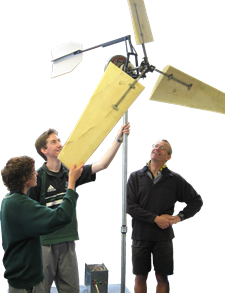Portable wind turbine

(Left to right) Chris Peck,
Kevin Anderson,
and teacher Ian Watson, with the turbine
(Click to enlarge)
Kevin Anderson
Otumoetai College
Year 13 Technology: full year project
Teacher: Ian Watson
Kevin's client enjoyed camping in remote spots with his family, but found that the battery life of many small electronic devices never lasted as long as he would like.
Kevin realised that a renewable energy source that could power a battery bank would be the best solution to this problem. After some research into several alternative power sources, he decided a portable wind turbine would best meet his client's specifications for a solution that was safe, cheap, durable, easy to set up and compactable.
Determining the correct generator was the crucial first step in the project. Kevin tested a number of different options, from automotive alternators to stepper motors, before deciding on a smart drive from an old washing machine. Smart drives perform well at the very low RPM (Revolutions Per Minute) generated by the turbine and have a high efficiency-to-weight ratio, making them relatively light.
To take advantage of low wind conditions it was important to make the drive as easy to turn as possible. Kevin decogged the smart drive by filing down each of the coil heads until they were curved, reducing resistance when the magnet passed over each coil.
Kevin also researched different wire thicknesses and ways of wiring the unit to achieve the maximum output, and found that an 8mm diameter wire was the most efficient for the voltages the turbine would be producing. Kevin used a wiring format that gave his client the option to easily change the output configuration to take advantage of both high and low wind speeds. For safety, Kevin fitted the device with both a manual brake to slow it down during high wind speeds and an electronic cut-out switch.
As wind is an inconstant energy source, a battery bank is essential for storing the power generated by the turbine. Kevin decided on a lead acid battery for its safety, low cost, durability and lack of memory – meaning that the battery can be partially charged and fully flattened intermittently without creating false end points to its voltage range (as happens in NiCd batteries) and can be discharged to within 90% without decreasing its life cycle.
Kevin described the design and construction of the propeller blades, as 'almost a project on its own'. He decided against pre-made blades, preferring to custom design them to work best with his unique generator. This was the most technically challenging part of the project. After consultations with an experienced technologist, Kevin eventually came up with a CAD model for the blade shape that he believed would get the best result.
Kevin shaped the blades in moulded foam and then covered this with a layer of fibreglass. This method was cheaper and easier than working with solid fibreglass and was within Kevin's existing skill level. It was also far lighter and quicker to make than many other methods.
The tower to support the blade unit was made from a pole and guy ropes. With the guy ropes providing side stability the pole only has to support weight from above, allowing Kevin to use a lightweight 30mm diameter pole with 3mm wall thickness. The pole was constructed of four individual sections joined by a threaded socket system. This was chosen over a telescoping rod as it was still compactable, while maintaining strength at the top.
Upon testing, Kevin found that the finished prototype met all his client's specifications, being easily set up in ten minutes and producing 20 watts of power in average wind conditions. The whole unit folds down into a compact 1000 x 300 x 300mm box and weighs within the client's 40kg limit.
Kevin's project not only solved all his client's concerns, but also received the major award in the Year 9-13 Technology category of the 2008 Transpower Neighbourhood Engineer Awards. The placing won a cash prize of $2,000 for his school. Engineer Brian Jackson was impressed: "This was a very challenging project for a secondary school student. It is an interesting mix of mechanical, electrical and electronic engineering, both academic and practical, and Kevin has applied himself to each aspect with a high level of skill and awareness."
Teacher comment
Kevin is an intelligent, motivated student and a very independent learner. He has learnt a lot this year, not only in the areas of technology and engineering but also in non curriculum areas such as communication, project planning, setting and meeting deadlines, and quality control. To make a fully functional wind-powered generator from scratch was an enormous achievement for Kevin and he should be very proud of his Top Scholar placing in Technology in the 2008 New Zealand Scholarship examinations.
Kevin's scholarship report on this project is featured in the Scholarships Materials section.






